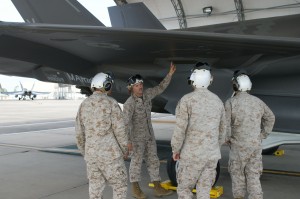7/26/2012 – EGLIN AIR FORCE BASE, Fla.
by Dan Hawkins, 82nd Training Wing
It’s no surprise much of the military these days operates in a joint environment. With the introduction of the Department of Defense’s newest fifth-generation fighter jet, the F-35 Lightning II joint strike fighter, the joint effort is at the forefront of the aircraft’s maintenance training needs through the efforts of the 372nd Training Squadron Field Training Detachment 19.
Although based in the Florida panhandle at Eglin, the detachment is part of Air Education and Training Command’s 82nd Training Wing, headquartered at Sheppard Air Force, Texas.
One of the unique features of the detachment is the stand up of the U.S. Marine Corps’ first-ever aircraft maintenance field training detachment by combining F-35 maintenance training operations with the Air Force and the Navy.
Utilizing the FTD will allow the USMC to train the initial core group of F-35 maintenance cadre to staff the creation of new F-35 maintenance squadrons throughout the Corps.

“We (USMC) decided that the Air Force model for maintenance training was the right way to do business,” said USMC Capt. John Park, 372nd TRS commander. “The Marine Corps, when we go to a platform, we stay there for our whole careers…so this is new to us. Having Marines move to the F-35 from the F-18 Hornet or AV-8B Harrier is unheard of, so it’s a big change in our training process.”
With crew chief, egress and environmental, avionics and airframes training, the 372nd TRS ensures Air Force and Marine Corps trainees are fully-qualified to work on the DoD’s newest weapons system.
“We have 10 Marines here right now as instructors,” Park said. “Right now we are focused on training and transitioning experienced Airmen and Marines to the F-35 from other airframes, getting the maintenance foundation set so they leave us to head to the field fully task-qualified.”
All the Marine instructors came to Eglin from the F-35 testing unit at Naval Air Station Patuxent River, Md., where they gained three years experience on the jet. The Navy is currently scheduled to start its own maintenance program over the next few months, with 10 instructors set to join the detachment.
Classes at the FTD range in duration from 45 to 90 days, depending on the specialty. Although trainees are transitioning to the F-35 from other airframes, the long-term plan is to send Marines through the initial training pipeline to build up the overall military specialty manning numbers.
Being able to train in-residence at Eglin, as opposed to out in the fleet in an on-the-job training environment, speeds up the Marines’ overall learning curve.
“We are trying to take a learning process that usually takes three to five years of on-the-job training in the Marines Corps and turn it into a 90-day or less class,” said USMC Staff Sgt. Chris Johnson, power line (crew chief) instructor. “It’s incredible what we can do with the best people and training in the world.”
Maintaining one of the most advanced weapons systems the military has ever seen is a source of pride for the instructors.
“My dad calls me probably every day and asks about the F-35,” said Air Force Staff Sgt. Jeff Kakaley, F-35 crew chief instructor. “I tell him I’m proud to work on it and he’s proud to have a son who works on the F-35 too.”
“Being around this aircraft on a daily basis, both here and at Pax River (NAS), has been awesome,” said Johnson. “There’s nothing I’d rather do.”
The 372nd TRS, part of the 982nd Training Group at Sheppard Air Force Base, Texas, has 28 detachments around the globe. The 982nd TRG conducts hands-on aircraft, munitions and communications-electronics training at 46 locations worldwide, including Europe, Alaska and the Pacific theater.


